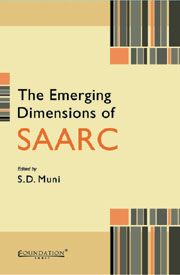Book contents
- Frontmatter
- Contents
- Preface
- List of Figures
- List of Tables
- 1 SAARC Prospects: The Changing Dimensions
- 2 SAARC and South Asian Economic Integration
- 3 Coping with the Emerging Challenges: Poverty and Food Security
- 4 SAARC Energy Cooperation: Energy Security and Environmental Challenges
- 5 Sub-Regional Cooperation under SAARC: An Economic Analysis
- 6 SAARC: Social Charter and Human Security
- 7 SAARC and the South Asian Security Architect
- 8 Fighting Terrorism through SAARC?
- 9 SAARC and the Evolving Asian Regionalism
- 10 Role of SAARC Observers: Members' Perspectives
- 11 Role of SAARC Observers: Observers' Perspectives
- 12 Concluding Remarks
- About the Contributors
- Index
Preface
Published online by Cambridge University Press: 26 October 2011
- Frontmatter
- Contents
- Preface
- List of Figures
- List of Tables
- 1 SAARC Prospects: The Changing Dimensions
- 2 SAARC and South Asian Economic Integration
- 3 Coping with the Emerging Challenges: Poverty and Food Security
- 4 SAARC Energy Cooperation: Energy Security and Environmental Challenges
- 5 Sub-Regional Cooperation under SAARC: An Economic Analysis
- 6 SAARC: Social Charter and Human Security
- 7 SAARC and the South Asian Security Architect
- 8 Fighting Terrorism through SAARC?
- 9 SAARC and the Evolving Asian Regionalism
- 10 Role of SAARC Observers: Members' Perspectives
- 11 Role of SAARC Observers: Observers' Perspectives
- 12 Concluding Remarks
- About the Contributors
- Index
Summary
The idea of planning a series of seminars on the South Asian Association for Regional Cooperation (SAARC) and putting together the seminar presentations in the form of a book was conceived by the Director of the Institute of South Asian Studies Professor Tan Tai Yong and the Senior Research Fellow Ambassador See Chak Mun. I am thankful to them for entrusting me with the responsibility to execute this project. The question that naturally arose was why study SAARC? Though it has produced formidable intellectual rationale and documented profuse rhetoric of political promises for development cooperation in South Asia region, has delivered very little even after more than twenty years of its existence. There is a two way answer to this question. One is that over the past more than a decade, the SAARC agenda has been somewhat hijacked by the economists who have explored the potential of what SAARC can achieve in the field of economic cooperation, particularly trade. In the process, other aspects of SAARC activities have been neglected. Therefore, there was need to look at SAARC in all its aspects, covering not only trade and economic dimension but also the security, political and cultural aspects of regional cooperation among the South Asian countries.
Secondly, over the past five years, small but significant changes have been taking place in South Asia having decisive impact on the process of regional cooperation.
- Type
- Chapter
- Information
- The Emerging Dimensions of SAARC , pp. v - viPublisher: Foundation BooksPrint publication year: 2010

